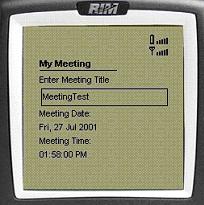If you're waiting for idea #5 pt. 2, then here it is.
To recap, I suggested that operators capitalise on the targeted advertising techniques currently making waves on the Internet, like Google's ad-sense. This is a big topic in itself and has many interesting nuances and evolutions (e.g.
Sell-side advertising).
There are myriad ways that advertising can be incorporated into the mobile experience. BUT, don't forget the golden rule - ads have to be permission based and relevant. For more on this, follow anything written by permission-marketing guru
Seth Godin.
Those of you who followed my old blog will know that I have written lots about location-based advertising (LBA),
exploiting cookies and related topics. The common rebuttal against LB-ads is the spam threat. We already hate email spam and thus far mobiles have managed to stay fairly clean of such filth (for now).
However, as I also discussed,
mobile location spam needs thinking through. Users might actually want to receive ads if they're ready for them. This is what permission-based marketing is all about. We shall return to LB-ads in a later post, as my main concern for now is elsewhere.
What interests me here is how do marketers extend the conversation to the consumer through mobile channels from conventional ad channels. In other words, can we turn the increasingly ineffective poster boards, print ads and TV ads into something more "ad-sense" like?
The answer is yes, and I believe that that the possibilities are huge and exciting, especially when mobile TV arrives and its potential to run in parallel with other channels, a bit like the
visual radio trial with Nokia and some radio stations in the UK.
However, in the meantime, we need a simple way to "mobilise" existing adverts without requiring new technologies.
In
part 1 of this post I asked you to read first my
previous article about using numbers to access content, rather than those crazy
difficult-to-enter URLs.
Well, that's what the idea is, but with a biz model attached this time around.
There seems to be scope for an agency to sell ad-numbers. These are "phone numbers" you can place in an ad, or on anything you like. With some words like "Dial 1234 for mobile info on your mobile". The user dials 1234, which is trapped by the operator network as an ad-number and triggers the appropriate messaging response.
Technically, this is all straightforward, so we will avoid the techie discussion (perhaps for a later post, but Parlay gateways bring "number trapping" into the world of web services, which means this whole idea is easily extended to the net community).
The idea is that you dial the number and your mobile is sent to a nano-site where the user can browse more information, register their interest etc.
This solution is better than interactive text because it's a good deal simpler. Don't forget that we are interested in anyone, regardless of age and tech-savvyness being able to ask for more details, so dialling is more familiar than browsing or keywords.
The biz model is pay-per-dial, which, as we all know, is how Google can attract so many advertisers. And, just like with ad-sense, an advertiser should be able to sign-up online and start using ad-number within minutes, without talking to any ad-sales reps.
What's more is that this technique can be used for permission-based location advertising. Ad messages sent to the mobile upon request could include "in your area" ads for stockists of the product in the user's vicinity. Advertisers also get to know where a user was when they asked for the info - which is good for monitoring poster board effectiveness.
OK, there are issues here that need refining, but the basic idea is sound and seems worth exploring. What's more, is that it can work today on most phones (because most of them have browsers and WAP-push). We don't have to wait for the more elaborate interactive ideas based on bar-codes etc.
In my book, I already discussed the idea of using numbers instead of URLs, but I felt that users probably needed to become cognisant that they were dialling "pages" rather than "people", so I suggested an additional button on phones to make the distinction. In fact, the button can be the "dial" button with an added symbol, which I was suggesting should be the "@" sign. If the button were separate, then here's what it might look like:

That's all for now...we can return to this idea later.




